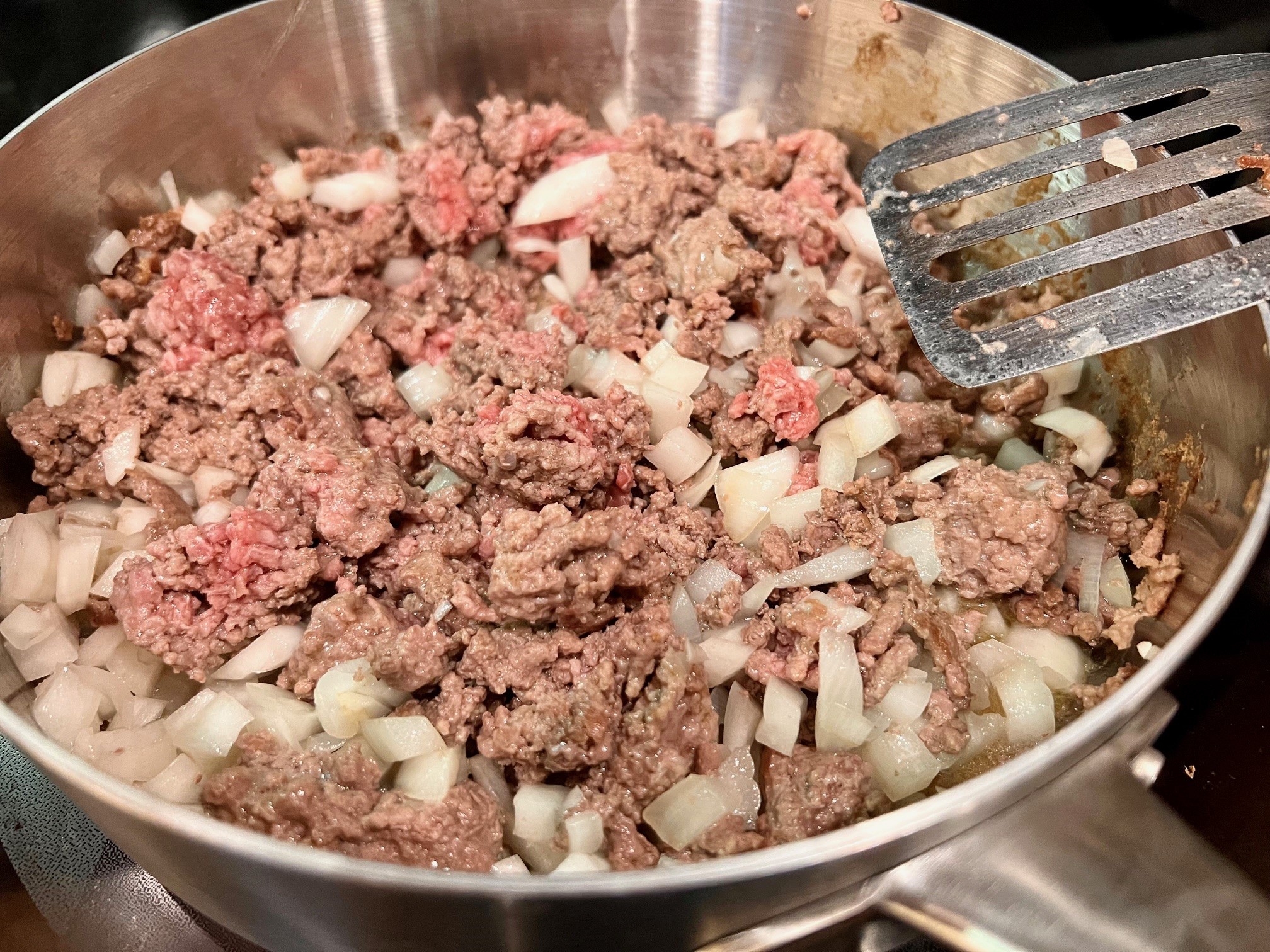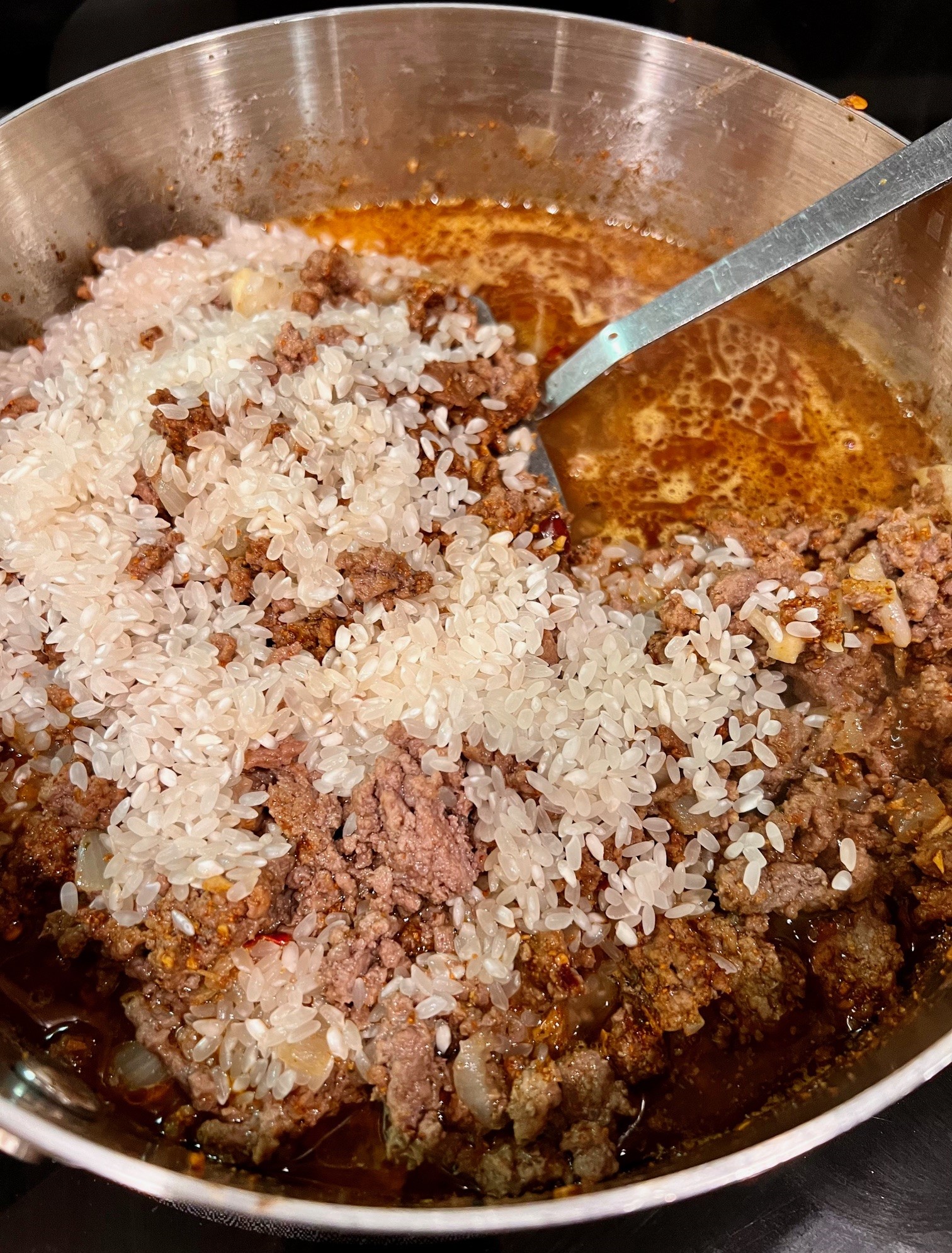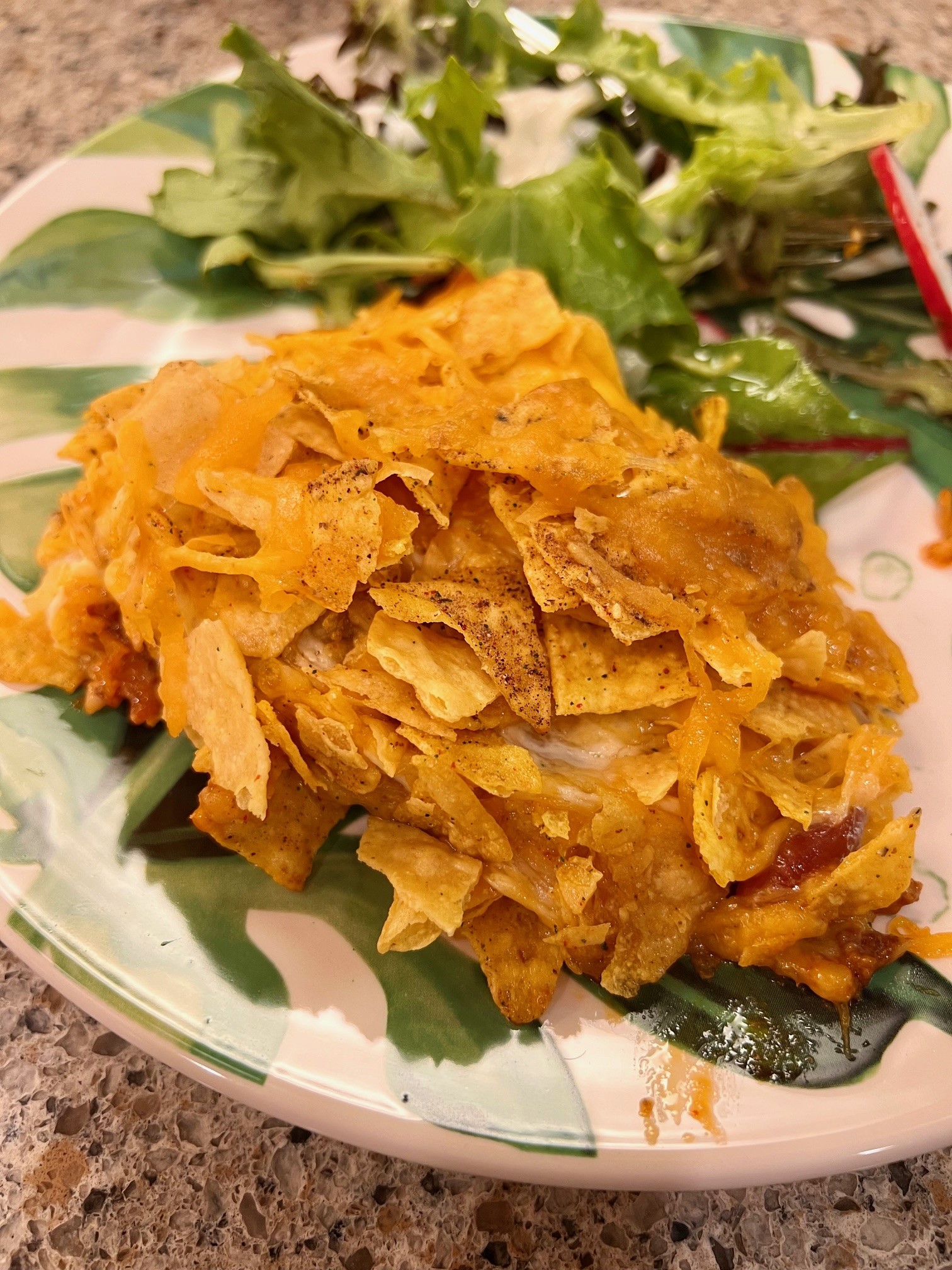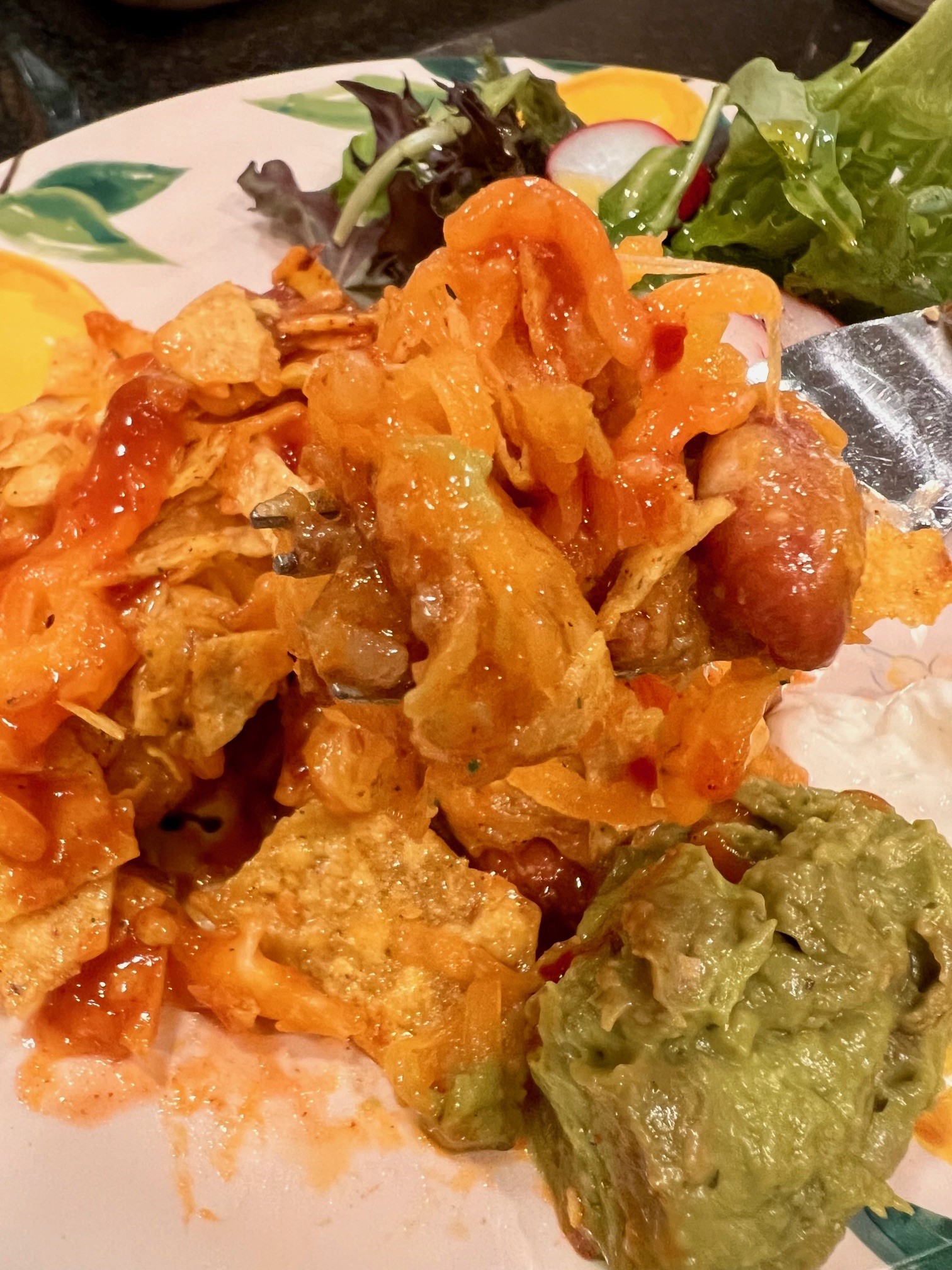Last Thursday night I discovered one of the most delicious recipes I’ve made from The Joy of Sharing so far: Cheryl Vinesett’s “Taco Hot Dish.” I made it for a late supper on one of our later nights after dance, and it was satisfying and tasty.
Pantry Staples?
As do so many hotdishes or casseroles in other areas of the United States, this hotdish relies upon ingredients many cooks may have had in their cupboard, fridge, or freezer: ground beef, onion, tomato sauce, rice, beans, and cheddar cheese.

The only specialty ingredients a cook may have had to shop for might have been the taco seasoning blend and the chips, possibly. But “taco-flavored chips,” imply Doritos to me, and even if tortilla chips and salsa weren’t as ubiquitous in home kitchens in rural North Dakota in 1985, as they are now, Doritos may have been. They’ve been around since 1966, when a Disneyland restaurant owned by Frito-Lay fried up pieces of unused, stale tortillas, in reference to the Mexican totopo; the cheese flavor appeared in 1972. The popularity of tacos in general, as well as the concession-stand fare called the “Walking Taco” or more commonly, “Taco in a Bag” certainly points to the possibility of both taco seasoning and cheese-flavored Doritos already being on the shelves of most kitchen pantries.
Okay, I need to pause for a moment to comment on how ingeniously literal, and wholly unappetizing these dish names are. Particularly when you pronounce “bag,” as folks with Northern Plains’ accents do—think “eh.” Like a dish that is hot, it’s a taco but in a bag, a taco you can walk around with (note how I also used the northern regionalism of ending with “with.” Even though I love to flout Robert Lowth’s prescriptive rules antithetical to English’s linguistic history and thus am happy to end sentences with prepositions, I do think there’s some illogic in this colloquialism. But it’s my heritage and my legacy too. I’m sure my daughter will also “bring that with” throughout her life or perhaps consume a taco she can walk around with. But I digress).
“Taco in a bag” and “walking taco” are regional monikers for the regional mashup meal of a taco and a taco salad: ground beef with taco seasoning, cheddar cheese, “taco sauce” from a company like Pace or Ortega, some shredded iceberg lettuce, diced onions, tomatoes, and perhaps some tasteless black olives, all aboard a bed of nacho-cheese-flavored Doritos, in the Doritos’ snack-size bag cut open, with a fork stuck in it (undoubtedly influenced by the Frito Pie, a snack-bag of Frito-Lay’s Corn Chips topped with chili and cheese). How does this improve on the taco—a hand-held meal in itself?
But the greater Velva area has its own particular names for items too, like “taco chips” for what everyone else in the United States calls tortilla chips. I remember the look of revulsion on my husband’s face when he heard someone refer to sloppy joes as “slushburgers” for the first time. And he’s not wrong. But are sloppy joes that much better? Yes, he would adamantly insist. But I can’t stop picturing a greasy line cook named Joe. Calling this sandwich “Manwich” isn’t better, since it 1) gives credit to a brand name that just capitalized on a popular product, and 2) this product’s name is a sexist portmanteau, splicing “man” with “sandwich” and suggesting this is a “manly” sandwich. Because it’s messy? Filled with meat and sauce? I don’t know, but I certainly can’t support this name for this type of food. Women are having a hard enough time in 2024. Calling them “barbecues” like the famous Moorhead Dairy Queen (where the Dilly Bar was invented!) makes you wonder if the owners have ever been to Kansas City (or North Carolina or Texas for that matter). The sauce is adjacent, I suppose, but come on. The best name, really, is Cobber Joe, which is what Concordia College dining services call Sloppy Joes. So let’s use that, going forward.
A Return to This Hotdish….
Since I had an open bag of Cool Ranch Doritos (arguably the best flavor of Doritos) in my own pantry, I decided to use a mix of Doritos and tortilla chips. If the recipe had specified “taco chips,” rather than using the hyphenated adjective “taco-flavored,” I would have understood the chips to be what I call tortilla chips, but my mother still calls taco chips (see the influence of Northern ND monikers above).
This swift evening meal begins just like making tacos–browning the ground beef and sautéing the diced onion in the beef fat.

Then I added the taco seasoning we had on hand, in a seasoning container from Costco. We like that mixture, though it would be fun to make my own too. For the pound of ground beef I had thawed (a little under the amount specified by the recipe), the taco seasoning instructions specified using three tablespoons, which I prefer to mix into the ground beef before adding the three quarters of a cup of water. I’m not sure if it makes a difference, but I hope it helps the seasoning coat the meat.


The instruction’s phrasing is interesting here: “Brown meat and onion, add taco seasoning and water per seasoning directions. Add rice and ½ cup water. Next add tomato sauce. Simmer, covered 20 minutes, then add beans.” The periods separating each imperative sentence imply to me a next step, with more space in between the actions, like the separation between adding the tomato sauce and simmering. However, the first three sentences could be rewritten into a series, which is how they are performed: “add taco seasoning and water per seasoning directions, add rice and ½ cup water, and then add tomato sauce.” While this is essentially a list of sequential actions, all after the beef and onion are ready, the period’s separation fools the reader’s eye into assuming a pause in a recipe. I imagine the sentence-boundary decisions were made for clarity (either by Vinesett or in her source) to avoid an overly long, complicated sentence (also not great in a set of instructions!). Fascinating.
Continuing to follow the recipe’s guidance, I did add those ingredients and let the mixture simmer on the stove top, stirring occasionally to keep the rice from coagulating on the bottom of the pan.


After folding in the kidney beans I had on hand (I’d love to try this with the optional refried beans; I imagine it would produce an even thicker, creamier texture), I transferred everything to a baking dish.

Then, I sprinkled the shredded cheese on top, followed by my chip blend, and some extra cheese on top of that. While the cheese on the top changes the texture of the crunchy topping, it does mimic nachos, which seem to be pretty popular.

Tasting Reflections

After twenty minutes in a 325-degree oven, we fixed plates of hotdish with a green and radish salad and dug in. The hotdish was well-received by my family, though my daughter advised removing the beans, which I think is wise. Kidney beans have always seemed so dry to me; those locales whose signature chili has no beans are on to something. My husband said, “I’m actually going to go get more,” which was kind of amazing since 1) this was a hotdish, and 2) I had served him a very generous portion. I thought “Taco Hot Dish” was delicious—crunchy on top, and creamy underneath, with a chewy, grainy hamburger and rice combination and a rich sauce from the taco seasoning mixed with tomato sauce. Since we like things spicier than most of our Northern neighbors, I added hot sauce to the adults’ plates, and served all three plates with dollops of guacamole and sour cream.


Later that evening, as we discussed the hotdish again, my husband noted that the problem for us is having too much leftover. Normally that’s not an issue, since I do like leftovers, but he was concerned that the chips would be too soggy when reheated. But I’m game for trying experiments, and so I warmed some hotdish up in the microwave for lunch the next day. And it was great—since tortilla chips are corn tortillas fried until crispy, softened tortilla chips are basically corn tortillas. The leftover version of “Taco Hot Dish” was reminiscent of the use of torn-up, pliable corn tortillas in “Irma’s Chicken Tortilla Casserole” (https://blog.cord.edu/karlaknutson/2024/09/06/a-playdate-luncheon-irmas-chicken-tortilla-casserole/). Also like Irma’s version, “Taco Hot Dish” is flexible, easily tailored to the particular flavor profiles of the group or the individual diners; preferred elements adding spice or flavor, like chilis, sauces, and cilantro could be incorporated into the hotdish mixture before baking or added onto individual plates at the end.

As I discussed in the post about Irma’s casserole, these fusion dishes draw on global cuisines that became popular with American home cooks and cookbook writers during the twentieth century, as they embraced the opportunity to experiment and innovative, and sometimes, unfortunately, appropriate. This is how Tex-Mex and American-Mexican food was created—innovative adaptation based on assumptions.
Contributor: Cheryl Vinesett
Cheryl Grindberg was born on April 30, 1948, to Victor and LaVina (Krumwiede) Grindberg (also a contributor to The Joy of Sharing previously featured for “Chocolate Marshmallow Squares”: https://blog.cord.edu/karlaknutson/2023/06/15/chocolate-marshmallow-squares/). Cheryl was the second oldest of LaVina and Victor’s four children, and the family lived east of Velva on what had been the McHenry County Home Farm or “poor farm” between 1923 and 1946. Cheryl graduated from Velva High School, and in 1972 married Ossie B. Vinsett, Jr., who was born in 1943 to Lona and Ossie Vinesett, Sr., of Gaffney, South Carolina. Ossie served twenty years in the United States Air Force, retiring in 1982, and then attending Minot State. As Minot has an air force base, I assume this is what brought him to the Minot area, where he must have met Cheryl. The couple have three children: Lynn, Carl, and Samantha, and reside in the Velva area. Cheryl’s other contributions to The Joy of Sharing include “Spiced Cider,” “Southern Banana Pudding,” and “Glorified Orange Rice.” After this great hot dish, I’m eager to check out her other recipes.

This post is part of an ongoing series in which I make and reflect on recipes and the people who contributed them to the 1985 Oak Valley Lutheran Church compiled cookbook, The Joy of Sharing.

